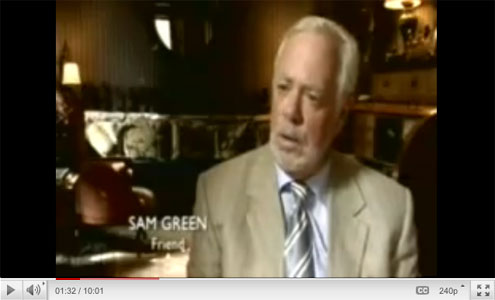Sam Green Obituary
Gary Comenas (2011)
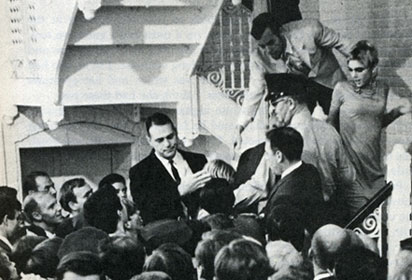
Left: Sam Green with Edie Sedgwick at the top of the ICA stairs as they try to escape from the mob
Sam Green - the curator responsible for Warhol's infamous 1965 ICA exhibition where Warhol and Edie Sedgwick were mobbed - died on March 4, 2011. He was born Samuel Adams Green on May 20th in (reportedly) 1940. (SD) He gave a later year of birth when interviewed in 2008:
Sam Green (2008):
"I was born in a small town in Connecticut in 1941. My parents were university professors, so while my friends went to baseball games with their dads, mine would take me to see houses of architectural interest. He instilled in me a lifelong love of art and architecture. After studying at art school, I moved to New York and sought whatever work I could get in galleries. In 1962, the year after my arrival, I was managing the well respected Green Gallery when an unprepossessing man came in one day and introduced himself.
'Hi, I'm Andy. Andy Warhol. I'm an artist.' I shook his extended hand. 'Sam Green.' 'Really? OK. Hi, Sam. I wonder if I could interest you in seeing my work.'
Later, after we had become firm friends, Andy confided that he had assumed by my surname that I was the gallery owner's son, so he'd made a point of cultivating me. At that time he had been working as an illustrator and was not yet famous as an artist. He was a few years older than me but we started to hang out together and got on really well. He was very funny, with amazingly original ideas... We spent one summer persuading wealthy socialites to let us film naked models in their bathrooms. Attractive young women - and men - fell over themselves to show how liberated they were by stripping for us, and the well-to-do were happy to have naked young people cavorting in their homes. This was the sixties: such behaviour wasn't really considered so bizarre then." (SF)
Art writer John Gruen described the Green Gallery as an "important stepping-stone for every major American Pop artist." (PO37) Warhol's friend Ted Carey recalled seeing the work of James Rosenquist at the gallery and telling Warhol about it at a time when Warhol was still without a gallery:
Ted Carey:
I can remember right about this same time, going to the Green Gallery, and I remember I called Andy. I said, 'There's somebody at the Green Gallery called Rosenquist, who's doing paintings, like a bottle of 7 Up.' I said 'They're fabulous.' I can remember saying 'I think they're really wonderful. I think I'd like to buy one.' And Andy said, 'Oh.' He said, 'If you buy one of those paintings, I'll never speak to you again.' I mean, he was just so depressed that it was all happening and he was not getting any recognition..." (See here)
Green left the Green Gallery (which was actually owned by Richard Bellamy with backing by Robert Scull) in the autumn of 1964 and become the director of the ICA, where he would remain until 1968. Prior to the Warhol exhibition at the ICA in 1965, he had included some paintings by Warhol in an exhibition he organized at Wesleyan University in 1964. (JW76) (Sam's father, Samuel Magee Green, was a professor at Wesleyan from 1948 to 1974 - and also wrote the textbook American Art: An Historical Survey.) (SA)
Green also appeared in Warhol's films, Batman Dracula and Soap Opera. One of the actors in Batman Dracula, the singer Tally Brown, recalled meeting Sam for the first time on the set. He was behind the camera at the time and she assumed he was the director of the film or the stage manager.
Tally Brown (Andy Warhol's Art and Films):
"... I went upstairs and I saw this sofa in the middle of the Factory, which was one open space there: a huge loft completely open. There was this nice comfortable Victorian sofa which looked like me. It was curvy and round and fat. And I asked somebody, whom I assumed was the director because he was behind the camera - he looked authoritative to me - and you're used to asking when you're a stage actress, the stage manager, whether you can do something. He's the authority figure. So I figured he must be the stage manager. What did I know? I was stoned, and I had been stoned for four days and I hadn't slept for four days. And I said, 'May I lay down and take a nap on that sofa?' And he said, 'Certainly.' And the the whole afternoon, I was trying to sleep. and various strange people kept gathering and attempting to relate to me in one way or another...
Normally, I'm very aware, and I'll understand what's happening. I just wanted to sleep. And that man... turned out to be Sam Green who... was a very strong advocate of Andy's work." (PS233)
The following year Green organized the Warhol show at the ICA - a show he billed as a retrospective despite the fact that it was only about four years since Warhol first painted his Soup Cans. The poster for the show featured Warhol's S & H Green Stamps and was signed by the artist - except that the signature was actually that of Green rather than Warhol. He demonstrates the signature in footage from Chris Rodley's BBC documentary Andy Warhol: Denied.
From Andy Warhol: Denied (Dir. Chris Rodley)
On You Tube here
Sam Green:
"... I had to sign them all [the S & H Green Stamp posters for the show] 'Andy Warhol' because he decided not to sign his work that year. In fact that was the year he applied to the Library of Congress to have his name officially changed to John Doe - so he wasn't going to sign anything. So it is actually my signature 'Andy Warhol 1965' that authenticates a Warhol as being real... because Andy Warhol delegated the responsibility to me of making his art... I've heard that Sotheby's will authenticate an S & H Green Stamp poster if it has my forged signature on it... If somebody else has forged the signature than it's not an Andy Warhol."
By the time of the ICA retrospective Warhol had left his original dealer, Eleanor Ward, and signed with Leo Castelli. Green talked about the circumstances surrounding Warhol's split from Ward's Stable Gallery in an interview originally published in 1971:
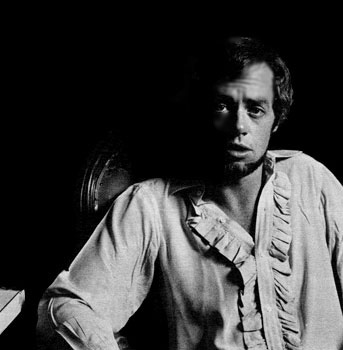
Sam Green
(Photo: Shunk-Kender, 1968)
Sam Green (The Autobiography and Sex Life of Andy Warhol):
"There was bitterness, I think, over the money about the split... it turned out to be fairly nasty in the end. At the same time, Eleanor was using all of her charms on me to get Andy to not do it, and to say what a terrible gallery Castelli was and how it was going to fall apart and how he was being brought into Castelli's as a way to kind of destroy him as competition within the organization. She was doing that sort of thing, and I was trying to explain all that to Andy because I believed her. A very funny thing has happened to Andy as it regards the works of art, and I don't know exactly when it happened. For a long time he was terribly generous, gave away things a lot, and then suddenly he became terribly parsimonious about it; he really thought of it as currency that he was giving away... Now it's like nobody gets anything under any circumstances... I think enough people he trusted who were buying his works because they wanted them suddenly made a bundle of money on them... The only people who are making money on the paintings are the ones who bought them long ago. So Andy got $200 for something that is being sold for $15,000 now...
Every time he does something I'm staggered. When I saw the Brillo Boxes I thought My God Warhol, what have you done? Look what you're getting away with. Use some common sense; nobody's going to want those! And then he came up with those aluminum pillows, and I thought, honest to God, Nobody could sleep with these in the same room... God knows, for example, what he's going to do with a snow machine, but I'm sure it's pure genius... Who knows what will happen? Somebody will write it up in Time magazine, and all of sudden it will become very conspicuous to everybody that Andy Warhol has suddenly become God, if that's what society wants." (JW76-7/79)
Sam was also a friend of Warhol star Candy Darling, who moved in with him in 1971 and lived with him for two years. (SD) He was one of the people she said good-bye to in a letter she wrote before dying, referring to him as "a true friend and noble person." (CD123)
Other New York friends included Greta Garbo, Cecil Beaton, John Lennon and Yoko Ono. John Richardson recalled one of Sam's Garbo stories in his book Sacred Monsters, Sacred Masters:
John Richardson (Sacred Monsters, Sacred Masters):
"One winter's day, Sam was accompanying Garbo on one of her interminable walks in Central Park... As she and Sam were about to enter the park, a large limousine screeched to a stop, blocking traffic and causing considerable consternation. A distraught woman jumped out and rushed toward Garbo, who ran off like a startled hare, leaving Sam to cover her retreat. Sam went through the drill that Garbo had devised for these occasions: politely and lengthily explaining that Miss Brown never talked to anyone. 'But you don't realize who I am,' the woman kept repeating. 'I'm Liv Ullman and I'm playing Anna Christie'... 'Sorry, said Sam, ' but there is nothing I can do,' and off he ran to catch up with Garbo, who was angrily stamping through ice-covered puddles. 'And what was all that about, Mr. Green?' 'That was your famous compatriot, Liv Ullman,' explained Sam. 'Liv Ullman? Never heard of her,' said Garbo.
At least that is the way Sam told me the story, and the way I told it to a friend of mine, who repeated it with embellishments to his sister-in-law... who in turn repeated it back to Garbo who was furious. 'You know, it's not true,' she grumbled to Sam. 'I'm afraid I misled you about the punch line,' Sam told me when we next met. What Garbo actually said was, 'Liv Ullman! This will make me the most unpopular man in Sweden.' 'Man?' 'Yes, man,' Sam repeated, 'she often refers to herself that way.'" (JR175-6)
Garbo ended her friendship with Sam after she discovered he was tape-recording their conversations and playing the recordings to friends. (NYSD1403111) The tapes were eventually bequeathed to Wesleyan University. (SI)
Green was friends with Cecil Beaton when Beaton photographed Warhol and his cohorts in 1969. At the time, Beaton described the atmosphere of the (second) Factory in his diaries as "the haunted world presided over by the zombie, more dead than alive since he was shot, of Andy Warhol." (BS381) He also noted that Sam Green "got me in exchange for photographs a Warhol silk screen of M. Monroe." (BS382) Green and Cecil traveled together to Jamaica in November of the same year. (BS456)
In regard to John and Yoko, Green became such good friends with them that he was named in John's will as an guardian for John and Yoko's son Sean if anything happened to Yoko.
Sam Green:
"I had met Yoko Ono before I met John Lennon. She shared an apartment with a Japanese artist I admired called Yayoi Kusama. Yoko fancied herself an artist and whenever I went to see Yayoi, Yoko would say: 'Sam, you have to see my new work. It is so fantastic.' After about the sixth time I said to her, quite bluntly: 'Yoko, I'm not interested.'
Then in 1974, she and John came to New York as a couple. A few days after they arrived, I got a call from Andy Warhol. 'Sam, you've got to help me,' he said. 'John and Yoko are insisting I introduce them to everybody in New York.' So Andy and I put together a party for them. John and Yoko sat in the corner, not saying much to anyone. Every night after that they wanted Andy to arrange something for them. After about five days of this he called and said: 'I just can't do it any more. They are so boring.' So I took up the cause and gradually we became good friends. They regularly invited me over to their apartment in the Dakota building, and I had them over to my place, just four blocks away.
I also accompanied them to Japan and Egypt, where I assembled a collection of ancient Egyptian art for them, including a sarcophagus containing the remains of a princess whom Yoko decided she had been in a previous life. It was when John made his will in November 1979 - just over a year before he was murdered - that he named me as Sean's guardian if he and Yoko died together. I discovered this only after his death. It was a total shock." (SF)
In 2008 Sam was the subject of a considerable amount of publicity surrounding the film Savage Grace in which it was claimed that Sam had had a threesome with the socialite Barbara Baekeland and her son, Antony. Green had met Barbara in 1969 and they had became lovers. Green recalls that they would go for long swims "and one day we found ourselves on a deserted beach where the inevitable happened." (SF)
Sam Green:
"She [Barbara Baekeland] later took me to her castle in Majorca where I met [her son] Tony, then 23. She had spoken of him as a sort of messiah, the greatest child there ever was, but I found him very disappointing. He was a poor little rich kid who couldn't decide if he wanted to be a poet or a musician or simply sit on the beach smoking pot all day...
One night at dinner, Tony suddenly got up, walked around the table and yanked Barbara backwards off her chair by her hair, dragging her towards the door. She remained entirely passive... Later in the evening, both behaved as if nothing had happened.
I arranged to send myself a telegram saying I was urgently needed elsewhere and made my escape.
My sexual relationship with Barbara had lasted for no more than four weeks. As far as I was concerned it was a fling, a holiday romance. But Barbara placed more significance on our relationship... She bombarded me with letters and calls... These days I think you would call her a stalker.
Then she started telling people she had had an incestuous relationship with her son as a way of 'curing' him of homosexuality. One of her friends said: 'Sons and lovers - nobody knows the difference anymore.'" (SF)
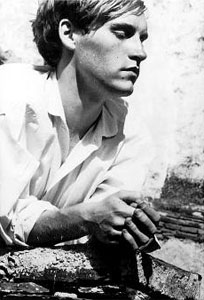
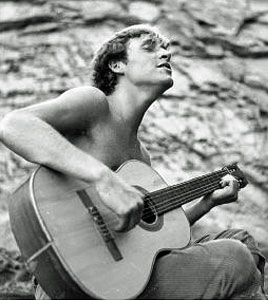
Tony Baekeland
(Top photo by Karen Redkai, bottom by Christopher Barker)
Barbara's son ended up murdering her. He was institutionalised at Broadmoor Hospital and released in 1980. After his release he went to live with his grandmother who he stabbed less than a week later. She survived but he was jailed on Rikers Island for the crime and died there from suffocation on March 20, 1981. It's not known whether his death was suicide or murder.
Sam Green (2008):
"It is true that almost 40 years ago I did have an affair with Barbara, but I certainly never slept with her son, and nor did she, to the best of my knowledge. Nor am I bisexual.
The movie producers have changed my sexual orientation but couldn't be bothered to change my name. I'm taking legal advice because the film damaged me and distorted a life that certainly needs no exaggeration." (SF)
During the late sixies Sam was appointed cultural consultant to New York City by the mayor, John Lindsay, and organized a number of outdoor sculpture exhibitions in the parks and plazas of the city. He also became involved with an organization called the International Fund for Monuments as their special projects director. In October 1968 he organized the exhibition of a head from Easter Island in the plaza of the Seagram Building. (SI) The event was covered by The New York Times in an article by Grace Glueck titled "5-Ton Head from Easter Island is Put on a Pedestal." (TO49) Apparently, Green helped to arrange the diversion of a cargo plane from Vietnam to transport the sculpture. (SI) He continued his efforts at saving sacred archeological artifacts and art by founding the Landmarks Foundation in 1997. (LF)
At the time of Sam's death the ICA in Philadelphia was planning an exhibition based on his 1965 exhibition of Warhol's work. The exhibition (titled "That's How We Escaped: Reflections on Warhol") is due to run at the ICA from April 21 to August 7, 2011.
Billy Name (March 15, 2011):
"I knew Sam Green very well - in the sixties, at the Factory and on the telephone. He was doing up his new loft and he asked me to come over and do his electrical work, but, alas, I refused. I would only work in the Factory at the time. Sam was a jolly fellow, very slim, always in a tie and jacket and fun to be with. I have a photo of him at the Factory looking very trim. I noticed his birth date in the obituary and it turns out I am 3 months older than him, he - May 20 and I - February 22, 1940. I made it to 71 but he died at 70. I always loved Sam, a charming character."
